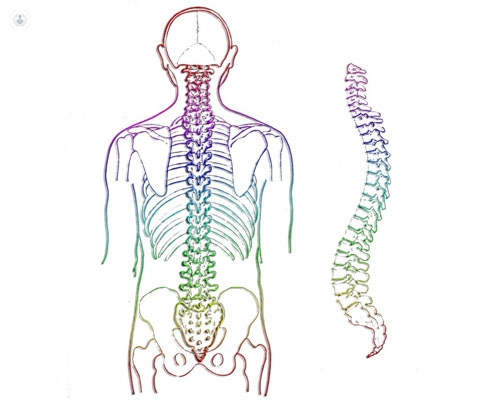

What is the spine?

Newborns’ spines have 33 bones, adults, due to the sacral and coccygeal vertebrae fusion during development, have 26. The vertebrae protect the spinal cord and allow you to stand and bend.
Vertebrae are stacked on top of one another and are grouped into four regions:
- Cervical vertebrae (C1 - C7). The spine is subdivided into two parts:
- Upper cervical region (C1 and C2). The C1 vertebra is called atlas and the C2 is called axis.
- Lower cervical region (C3 to C7).
The cervical bones are designed to allow flexion, extension, and rotation of the head. These are smaller than the other vertebrae, so they enable a greater amount of movement.
- Thoracic vertebrae (T1 - T12). The thoracic vertebrae increase in size from T1 to T12.
The thoracic spine connects the ribs in the chest region.
The spinal canal in the thoracic region is smaller than in the cervical or lumbar areas. This makes the spinal cord in the thoracic area be at a higher risk if there is a fracture.
The main movement of the thoracic spine is rotation. The ribs prevent bending to the side. A small amount of movement happens in flexing forward and backwards.
- Lumbar vertebrae (L1 - L5). The lumbar vertebrae vary in size from L1 to L5.
- The vertebrae bear much of the body’s weight as well as the related biomechanic stress.
Lumbar vertebrae are large, wide, and thick. The lowest vertebra, the L5, articulates with the sacrum, and the sacrum joins the pelvis.
The main movements of the lumbar area are to flex forward and bend back. It also allows for side-flexion.
- Sacral region. The sacrum is located behind the pelvis. The sacrum has five bones (abbreviated to S1 to S5) fused into a triangular structure. The sacrum sits between the hip bones that connect the spine to the pelvis. The last lumbar vertebra (L5) articulates (moves) with the sacrum.
- Coccyx. Directly below the sacrum, there are five bones that are fused together to form the coccyx (tailbone).
What does the spine do?
Some functions of the spine are:
- Protecting areas such as the spinal cord, nerve roots, and many internal organs.
- Ligament, tendon, and muscle support base.
- Structural support for the head, shoulders, and chest; it connects the upper and lower parts of the body; and provides balance and weight distribution.
- Flexibility and mobility
- Flexion (forward tilt)
- Extension (backward tilt)
- Tilt to the side (left and right)
- Rotation (left and right)
- Combination of the above
- Bones produce red blood cells, store minerals, and so much more.
What conditions can affect it?
There are several issues that could alter the structure of the spine or damage vertebrae and the surrounding tissue:
- Infections, such as vertebral osteomyelitis.
- Injuries
- Tumours
- Diseases such as ankylosing spondylitis and scoliosis.
- Ageing changes in the bones, such as spinal stenosis and herniated / slipped disc.
There are many diseases that affect the spine and cause pain when bone changes put pressure on the spinal cord or nerves. Another effect is limitation of movement.
Treatment will vary depending on the condition that is affecting the spine, but in many cases orthopaedic appliances are used or surgery is performed.
